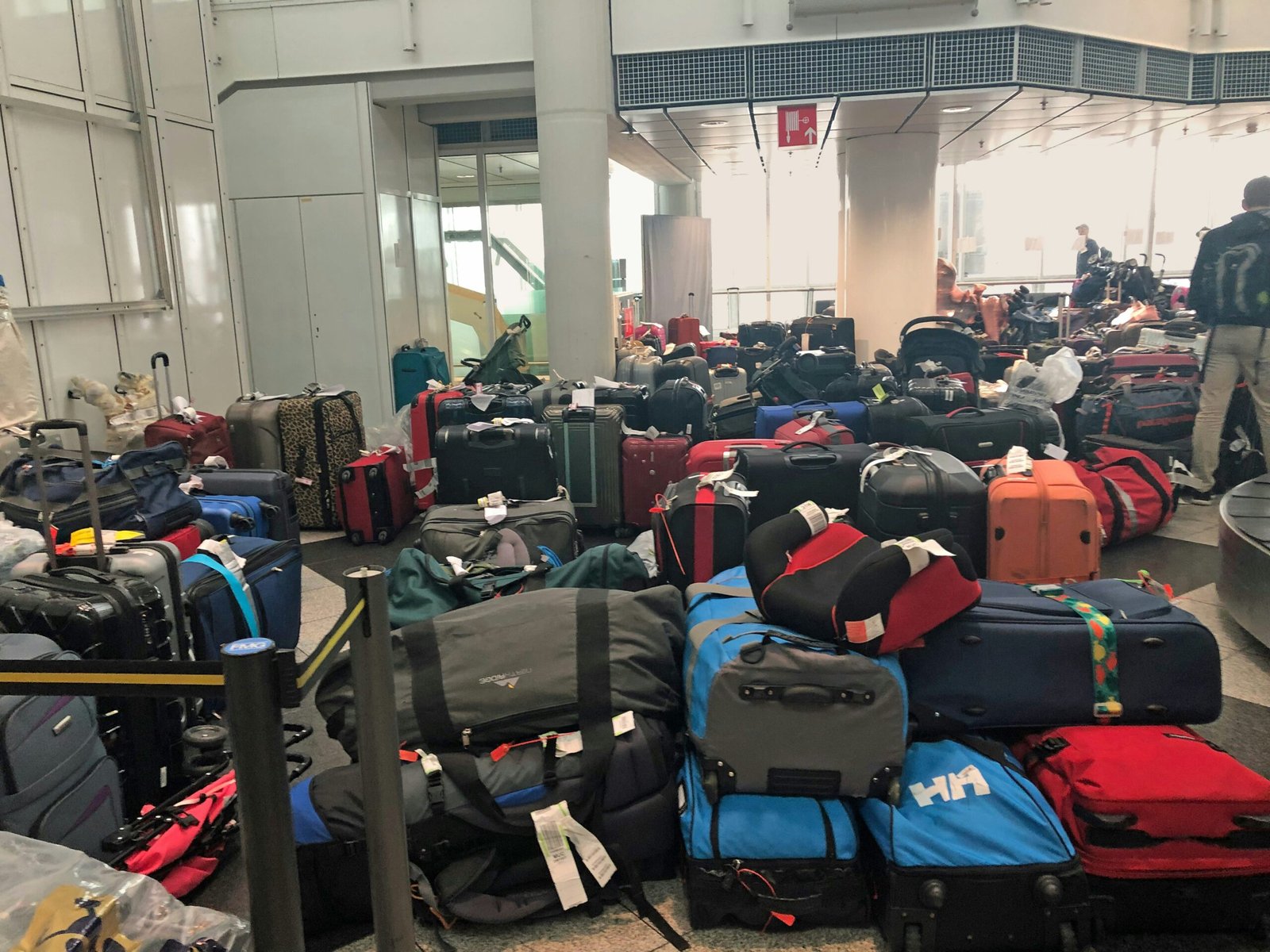
Understanding the Situation
Losing luggage during travel can be a concerning and distressing experience for many passengers. It is essential to understand the common causes behind such situations to remain calm and effectively handle the issue. Often, luggage is misplaced due to delayed connections, misrouted bags, or errors made by airline staff. Delayed connections occur when flights do not arrive on time, leading to insufficient time for baggage transfers, which can result in bags being left behind. This is particularly prevalent in airports with multiple terminals, where a tight schedule can further complicate the transportation of luggage.
Another common scenario involves misrouted bags. This situation can arise when luggage is mistakenly loaded onto the wrong flight. For example, a traveler heading to New York City might have their suitcase tagged for a flight to Los Angeles due to a simple clerical error. Such mix-ups can be exacerbated during peak travel seasons or busy international routes, where numerous flights are operating concurrently. Furthermore, the ‘hub-and-spoke’ model many airlines employ can increase the chances of your luggage being sent through an unintended path.
Moreover, human error in baggage handling can also contribute to lost luggage incidents. Overworked staff and high volumes of travel can lead to lapses in attention that may result in baggage mishaps. Each of these scenarios illustrates just how easily luggage can be misplaced, often through no fault of the traveler. By recognizing these potential causes, travelers may better empathize with their predicament and focus on the steps necessary to recover their lost belongings quickly. Understanding the context of lost luggage allows passengers to approach the situation with a clearer mindset, increasing the likelihood of a successful resolution.
Stay Calm and Assess the Situation
Discovering that your luggage is lost can be an overwhelming experience. However, remaining calm is essential in effectively addressing the situation. Panic can cloud your judgment, hindering your ability to resolve the issue efficiently. Begin by taking a deep breath and gathering your thoughts. Assess the situation methodically to understand the necessary steps to take.
First, head to the baggage claim area to ensure that your luggage has not been inadvertently overlooked. Sometimes, bags may be delayed or placed on the carousel out of order. Look carefully at the other bags; check if any look similar to yours, and verify whether you might have missed your luggage during the retrieval process. If you do not find your belongings, it is essential to seek assistance from the airline staff promptly.
Approach a representative at the airline’s desk, explaining your situation clearly and calmly. Provide them with relevant information, such as your baggage claim ticket, flight details, and a description of your luggage to facilitate the search. Keeping your claim ticket handy is crucial, as it acts as proof of your checked luggage and will be necessary for initiating a report.
Furthermore, collect information regarding the airline’s policies on lost luggage. Each airline has specific protocols for handling lost baggage, and familiarizing yourself with these can provide clarity on the next steps. Keep track of all communication with the airline, including names of representatives and timestamps of conversations. This documentation can accelerate the resolution, especially if follow-up actions are required. By staying composed and organized, you can significantly enhance your chances of recovering your lost luggage swiftly.
Report the Loss Immediately
Experiencing lost luggage at the airport can be a distressing situation, but promptly reporting the loss significantly increases the chances of recovery. Upon identifying that your luggage is missing, the first step is to approach the airline’s customer service desk located at the terminal. It is advisable to do this as soon as possible, typically before leaving the airport premises. This initial action is crucial in ensuring that your missing items are logged into the airline’s system without delay.
When you reach the customer service desk, be prepared to provide vital information pertaining to your flight. Essential details include your flight number, destination, and the baggage claim ticket you received at check-in. It can also be helpful to have your identification documents ready. The airline representative will likely ask for specifics about your luggage, such as its size, color, brand, and any distinguishing features. This information assists airline staff in identifying and tracking down your lost luggage efficiently.
After sharing the relevant details, you will be required to fill out a lost luggage report. This report serves as an official notification of your claim and records all necessary information regarding your belongings. Ensure you obtain a copy of this report for future reference, as it may be required for follow-up inquiries. Additionally, ask the airline representative about the expected timeline for updates regarding the status of your luggage. Understanding the procedures in place can clarify what to expect as your claim progresses.
In the unfortunate circumstance that your luggage is not found within a designated timeframe, inquire about compensation policies and the process for filing a claim. This proactive approach will help manage your expectations and provide insights on the next steps towards recovering your belongings.
Understanding Your Rights
When traveling by air, encountering lost luggage can be a distressing experience. It is vital for passengers to be aware of their rights regarding lost luggage, as airlines have specific policies and regulations that govern compensation and liability. Familiarizing oneself with these rights enables travelers to respond effectively if their baggage goes missing.
According to international regulations, particularly the Montreal Convention, passengers have rights in cases of delayed, lost, or damaged luggage. Under these guidelines, airlines are obligated to deliver compensation for lost baggage, subject to certain limitations. Currently, the compensation limit for lost luggage is generally outlined as approximately 1,131 Special Drawing Rights (SDRs), an amount that fluctuates with currency changes, equivalent to around $1,400 USD, depending on the exchange rate. This sum signifies the maximum liability of airlines for lost luggage, thus travelers should be aware of this cap when claiming compensation.
In addition to understanding the financial limits imposed by the airline, travelers should know what the airline is responsible for in these unfortunate circumstances. Airlines are expected to initiate the search for lost luggage promptly and keep passengers updated on the status of their belongings. Furthermore, travelers are entitled to reimbursement for essential items purchased as a result of the luggage loss, which should be documented and submitted for reimbursement.
If luggage is confirmed lost, it is critical for passengers to file a claim as soon as possible. Most airlines require you to report lost luggage within a specified timeframe, usually 21 days from the date of the incident, so it is essential to act quickly. Each airline provides specific mechanisms—either online or in-person—to file claims, typically accommodating the submission of necessary evidence such as baggage tags and receipts for any interim purchases made. By understanding these rights, travelers can better navigate the complexities associated with lost luggage and pursue rightful compensation diligently.
Keep Records and Documentation
When faced with the unfortunate event of lost luggage at the airport, maintaining detailed records and documentation is crucial. This practice not only helps to keep track of all communications but also strengthens your position should you need to escalate the issue with the airline. Start by recording every interaction with airline representatives, including the exact dates and times of your conversations, the names of employees you spoke with, and the information provided during these consultations. This thorough log can prove invaluable if discrepancies arise later.
In addition to noting verbal communications, it is essential to retain any written communication from the airline. This includes emails, letters, and text messages pertaining to your lost luggage. These documents can serve as tangible evidence of the airline’s acknowledgment and response to your situation. Furthermore, keep copies of all relevant documents, such as your baggage claim ticket, boarding pass, and any reports you file about the missing luggage. Each of these items should be stored in a dedicated folder, either digitally or physically, for easy access and reference.
In situations where you need to follow up with the airline or pursue compensation, having these records will enable you to present a clear and concise account of your experience. By illustrating your efforts to resolve the issue, along with the airline’s responses, you build a strong case. Documentation is not only a safety net for your claims but also an effective way to streamline the resolution process. Therefore, remember to treat every interaction as a potential record worth keeping. The more organized you are, the easier it becomes to navigate the complexities of lost luggage claims.
Stay in Touch with the Airline
Upon reporting your lost luggage, maintaining regular and consistent communication with the airline becomes paramount. As you navigate this unfortunate situation, establishing a dependable channel for updates can greatly enhance your experience and improve the likelihood of a speedy resolution. First and foremost, ensure you have documented your luggage claim reference number, as this will be essential for verifying your case with customer service representatives.
Utilizing multiple communication methods can be beneficial. Start by calling the airline’s customer service hotline to directly speak with a representative. Be prepared for potential waiting times; thus, consider calling during off-peak hours. When discussing your case, politely inquire about the status of your luggage, while providing them with your claim reference number. Following up via email can also prove effective. Compose a succinct message detailing your situation and request updates, while attaching any relevant documentation.
In-person visits can further reinforce your commitment to resolving the matter. If you are still at the airport, approach the airline’s baggage service desk to speak with an agent face-to-face. Personal interactions can sometimes accelerate the process as agents may feel a greater sense of urgency to assist you directly. When engaging with airline staff, ensure your communication is courteous and professional; a positive demeanor can foster goodwill, prompting the staff to prioritize your case.
Finally, establish a follow-up schedule. Depending on the airline’s policies and the initial timeline provided, check in at regular intervals—typically every two to three days. This approach keeps your case active in their system and demonstrates your proactive stance in seeking resolution. By maintaining open lines of communication with the airline, you position yourself more favorably in your quest to recover your lost luggage.
Claiming Compensation for Expenses
When faced with the unfortunate event of lost luggage, passengers often find themselves in need of essential items, such as clothing and toiletries. Fortunately, many airlines have policies that allow travelers to claim compensation for these necessary expenses. To initiate a compensation claim, it is critical to understand what constitutes reasonable expenses and the process involved in successfully documenting these costs.
Generally, airlines consider certain purchases as eligible for reimbursement. When luggage is delayed or lost, expenses for immediate needs, like basic clothing, hygiene products, and perhaps a few additional items, are typically seen as reasonable. However, travelers should avoid excessive spending. It is advisable to keep the claims within a modest and logical scope—purchases for items that are absolutely necessary to maintain comfort while awaiting the return of lost baggage.
In most cases, airlines establish a monetary limit on the expense reimbursement, which can vary significantly between carriers. This limit often reflects the duration of the luggage delay and is designed to cover essential needs only. It is essential to review the airline’s specific policies, as understanding the limits can help in making informed spending choices without exceeding allowable amounts.
Documenting expenses thoroughly is crucial for a successful compensation claim. To ensure reimbursement, passengers should retain all receipts related to purchased items, as these documents serve as proof of the expenses incurred due to luggage loss. Keeping a detailed account of the dates, amounts spent, and what each item was can also bolster a claim. Travelers are encouraged to submit these documents promptly, along with any required forms the airline may provide.
By adhering to these guidelines, passengers can effectively navigate the process of claiming compensation and alleviate the inconveniences caused by lost luggage.
What to Do if Your Luggage is Not Found
If you find yourself in the unfortunate situation of having your luggage go missing at the airport, it is crucial to take systematic steps to resolve the issue. Initially, contact the airline handling your flight to report your lost luggage, providing them with your baggage claim ticket and any information relevant to your travel itinerary. The airline will subsequently start a trace to locate your belongings.
Usually, airlines will keep you informed about the status of the search for your luggage. Typically, they have a standard timeline, where they will search for your lost items for a period of around 21 days. If your luggage is not located within this timeframe, it may be classified as ‘unrecoverable’. It is essential to keep detailed records of all your communications with airline personnel during this phase. Document names, dates, times, and any commitments made by the airline regarding the search for your lost luggage.
Should your luggage remain missing after the specified period, you will need to File a formal claim for compensation. Each airline has its own process for submitting lost luggage claims, which generally requires providing receipts for your travel expenses during the time your luggage is missing. In addition, you may be asked to produce proof of the value of the lost items. This could include receipts or photographs, so it is wise to maintain evidence of valuable items that you typically travel with.
If you encounter any difficulties or feel unsatisfied with how the situation is being handled, it may be time to escalate your issue. You can do so by contacting the customer service department of the airline or referring to their official complaint resolution procedures, often available on their website. Effective communication can lead to a resolution, so express your concerns clearly and provide any supporting documentation.
Preventive Measures for Future Travel
Travelers often experience anxiety regarding their checked luggage, particularly the possibility of it being lost, damaged, or delayed. To mitigate this concern and enhance overall travel experiences, implementing effective preventive measures is essential. One of the most fundamental strategies is to label bags clearly. A sturdy, visible luggage tag containing personal information—including name, address, and a contact number—can significantly aid in ensuring that lost items are swiftly returned to their owners. Additionally, travelers should consider adding a secondary form of identification, such as a written note with pertinent details inside the bag.
In recent years, the advancement of tracking technology has provided travelers with more resources to safeguard their luggage. Utilizing GPS-enabled luggage trackers can be a prudent decision, enabling individuals to monitor their bags in real time through mobile applications. This integration of technology not only enhances peace of mind but also facilitates timely retrieval should luggage go missing.
Another beneficial practice is opting for direct flights whenever possible. Connecting flights increase the risk of baggage handling errors, leading to potential mishandling or loss during transfers. By booking non-stop journeys, travelers can reduce the likelihood of their bags being misplaced. Additionally, choosing a reliable airline plays a crucial role in minimizing luggage mishaps. Researching an airline’s reputation for handling baggage effectively can inform better decision-making, ensuring a more reliable travel experience.
Incorporating these strategies into travel planning can help reduce stress related to luggage handling. By labeling bags, employing tracking technologies, prioritizing direct flights, and selecting trustworthy airlines, travelers can significantly lessen the chances of encountering lost luggage in the future.








